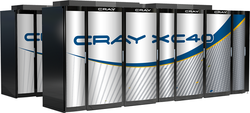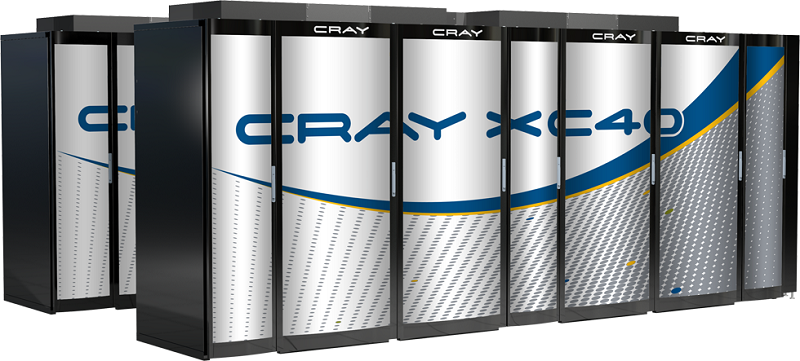
Feb. 10, 2017
By: Michael Feldman
Thanks to a record fourth quarter, Cray posted a modest profit in 2016, representing its seventh straight year of profitability. The company also recorded its second highest annual revenue in its history. Unfortunately though, Cray finds itself in the midst of a lethargic supercomputing market, which has shown few signs of improving.
First the numbers. For the year, Cray reported total revenue of $629.8 million. That represents a decline from 2015, when it took in a record $724.7 million. However, net income for 2016 was just $10.6 million, which is the narrowest surplus the company has posted in its seven-year streak of profitability. In fact, if it hadn’t been for the final quarter of 2016, which generated a net income of $51.8 million, the company could easily have been looking at a loss for the year.
 Total revenue for that final quarter of 2016 was $346 million, which was a company high. The record revenue was the result of completing acceptances on a number of some of the largest systems Cray has delivered. These include the three XC40 systems: the “Theta” supercomputer at Argonne National Lab; the “Cori” system at the National Energy Research Scientific Computing Center (NERSC); and a third one at Kyoto University. All are petascale supercomputers equipped with Intel Knights Landing Xeon Phi processors. Also accepted was an upgraded Piz Daint XC50 supercomputer at the Swiss National Supercomputing Centre (CSCS), yet another petascale system, but one equipped with NVIDIA’s latest Tesla P100 GPUs.
Total revenue for that final quarter of 2016 was $346 million, which was a company high. The record revenue was the result of completing acceptances on a number of some of the largest systems Cray has delivered. These include the three XC40 systems: the “Theta” supercomputer at Argonne National Lab; the “Cori” system at the National Energy Research Scientific Computing Center (NERSC); and a third one at Kyoto University. All are petascale supercomputers equipped with Intel Knights Landing Xeon Phi processors. Also accepted was an upgraded Piz Daint XC50 supercomputer at the Swiss National Supercomputing Centre (CSCS), yet another petascale system, but one equipped with NVIDIA’s latest Tesla P100 GPUs.
Cray CEO Peter Ungaro’s take on these results is that the company has weathered a rather tough year, in which they managed to outperform a slowing HPC market. He said that sales at the very high end of the supercomputer market were down by 25 percent for the year. The weak market is Cray’s biggest challenge right now, and one that, unfortunately, it has no control over. “While the market can be lumpy, we are continuing to see very slow conditions in supercomputing,” explained Ungaro.
Although there are only a handful of these really big supercomputers sold in any given year, they can generate a large share of Cray’s sales since each one can represent tens of millions of dollars. When the number of such systems drops even modestly, it can significantly impact the company’s revenue stream. In that regard Ungaro noted that they are seeing fewer opportunities, especially in their more elite customer base of national labs and top-end universities. “Overall what we’re seeing in the government is that they are tending to stretch out their procurements a little bit longer than they have typically,” he explained. “So they’re buying a little bit less often, but buying larger systems overall.”
The reason the company managed to remain in the black in such a year is that Cray’s win rate for these big systems is the best in the business right now. As a result, they are getting more than their share of supercomputers that are being purchased, fewer though they may be. There are a number of reasons for this, perhaps the most important one being is that Cray has clearly benefitted from competitors that have strayed from the high end of the market. Since IBM ditched its Blue Gene supercomputer line (in addition to selling its x86 cluster business to Lenovo), Cray became the most obvious alternative for customers retiring those now aging IBM systems. Yes, IBM is attempting to re-establish its HPC market with its Power CPU/NVIDIA GPU/Mellanox InfiniBand servers, but that’s a work in progress. Meanwhile SGI has been swallowed by HP Enterprise, leaving Cray as the only system vendor that can rightfully call itself a supercomputing specialist.
In addition, the company seems to have settled on a winning technical strategy to keep those customers coming back for more. In particular, they seem to have struck the right balance between customized integration and the use of off-the-shelf technologies for their most elite systems. Although the XC line still retains the proprietary Aries interconnect, all other major componentry is based on standard parts from Intel, NVIDIA, and commercial memory makers. If there’s a weakness to this model, it’s that Cray is reliant on these component makers to a greater degree than ever, which means the company’s product plans are dependent on their partners’ timelines. Nevertheless, Cray’s methodical roadmap for its supercomputers has provided its customers with a clear upgrade path in a way few of its competitors have managed to do.
The other parts of the Cray portfolio, namely the cluster systems (the CS series), the data analytics platform (Urika-GX), and the storage solutions (Sonexion and DataWarp) are not yet not big enough or mature enough to take up the slack when demand at the high end slows down. In particular, Ungaro said their cluster business was weaker this year, although they notched some good-sized deployments at NOAA, Kyoto University, and two unnamed commercial sites – one at an aerospace company, and the other at a financial services firm.
Likewise, the data analytics product set, based on the Urika-GX platform, is a very much a young business. In 2016, the University of Stuttgart installed two systems to support its aerospace and automotive industry partners, while Phizzle, a big data/IoT company, deployed another one for to support their analytics needs. Ungaro also mentioned a life sciences user, as well as a government customer that purchased multiple Urika-GX systems as part of their deep learning infrastructure, which also includes a GPU-equipped CS-Storm cluster. But all those systems together probably did not generate the revenue of a single large XC40 sale. While this part of the business might not be contributing much to the bottom line today, Ungaro thinks the data analytics space is a good long-term bet for the company.
Cray’s outlook for 2017 is a bit fuzzy since its dependent on the prospect of a renewed supercomputing market. Ungaro and company are being cautious since big supercomputers usually take the better part of year to be purchased, deployed, tested and accepted before the invoice gets paid. So they would have to see an uptick in the procurement of such systems in the first quarter of the year, and according to Ungaro, that’s not yet occurring. As of today, the company’s official guidance is that “it will be difficult to grow revenue compared to 2016.”
